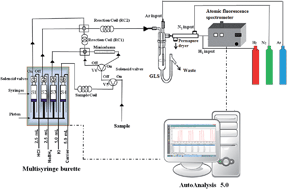A non-chromatographic automated system for antimony speciation in natural water exploiting multisyringe flow injection analysis coupled with online hydride generation – atomic fluorescence spectrometry
Abstract
A non-chromatographic automated system for the speciation and determination of inorganic and trimethylantimony (TMSb) exploiting multisyringe flow injection analysis (MSFIA) with hydride generation (HG) and atomic fluorescence spectrometry (AFS) is described. A cationic minicolumn was used for retaining the methylated forms of Sb which can generate hydrides, minimizing errors in the inorganic antimony speciation step. The optimization was performed in a multivariate way by employing a three-variable Box–Behnken design and a multiple response strategy. So, this method allows the quantification of Sb using the external calibration with aqueous standards. The method is suitable for monitoring drinking, surface and ground waters according to regulations established by the EU directives for antimony (5.0 μg L−1), and it was applied to the speciation of inorganic antimony and TMSb in several spiked water samples with recoveries close to 100%. The detection limits were 0.03 μg L−1 for Sb(III) and Sb(V) and 0.13 μg L−1 for TMSb. The method was satisfactorily applied to the determination of Sb(III), Sb(V) and TMSb in different water samples collected in Balearic Islands, Spain.


 Please wait while we load your content...
Please wait while we load your content...